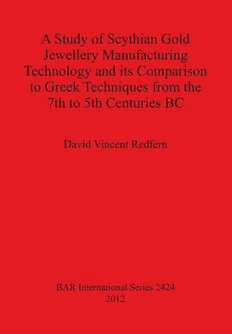
A Study of Scythian Gold Jewellery Manufacturing Technology and its Comparison to Greek Techniques from the 7th to 5th Centuries BC PDF
107 Pages·2012·47.928 MB·English
Most books are stored in the elastic cloud where traffic is expensive. For this reason, we have a limit on daily download.
Preview A Study of Scythian Gold Jewellery Manufacturing Technology and its Comparison to Greek Techniques from the 7th to 5th Centuries BC
Description:
This comparative study of Greek and Scythian jewellery manufacturing in the North Pontic region is based on a new technique developed by the author over a number of years to produce high-quality images of marks from tools used in the production of metallic artefacts. The macro-laser-imaging-technique was initially developed to overcome the limitations that were encountered when using a binocular microscope for the study of Anglo-Saxon jewellery. In this volume, Greek and Scythian jewellery from three sources was used: the Ashmolean Museum, Oxford, the Staatliche Museen zu Berlin Preussischer Kulturbesitz Antikensammlung, Berlin, and a private collection. The potential of studying the tool marks from artefacts from the north Pontic Region has been shown in aiding researchers in their understanding of the cultural interaction. It is potentially possible to discern which culture had produced the artefact by examining the technological techniques used to produce jewellery. The Scythian craftsmen had to develop techniques which would speed up the production of jewellery because, according to their burial customs, they only had a maximum of 40 days to produce grave goods, whilst the Greek craftsmen worked according to different economic criteria. The Greco-Scythian craftsmen produced artefacts that are in a Greek style but used different manufacturing techniques from those of the Greek craftsmen. These observed technical and qualitative differences provide the justification for a further systematic examination of a much larger collection of jewellery. Were Scythian "masterpieces" in jewellery really produced due to the introduction of gold manufacturing techniques by the Greeks or were they the product of a local and differing technological base?
See more
The list of books you might like
Most books are stored in the elastic cloud where traffic is expensive. For this reason, we have a limit on daily download.
